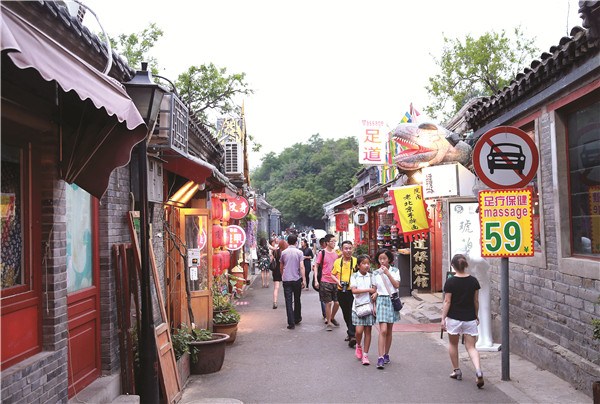
To name a few of the historic homes lost: the former residence of Cao Xueqin, author of Dream of Red Mansions, was demolished in 1999 to allow for the widening of a street. And, in 2012, the former home of Liang Sicheng, who is recognized as the"father of modern Chinese architecture", and his wife Lin Huiyin, who was also a renowned architect and writer, was razed despite the efforts of many organizations, including the CHP, to save it. (The couple's niece, Maya Ying Lin, designed the Vietnam Veterans Memorial in Washington DC in 1980 at the age of 21.)
While up-to-date numbers are sketchy, what we do know is the number of hutong in the Old City area almost halved between 1990 and 2005, when the total fell from 2,242 to 1,353, according to official data. The loss during those 15 years was heavier than the total destroyed during the 40 years from 1949 to 1989.
Much of the drive to redevelop hutong areas in the past has been inspired by a desire to improve the physical living conditions of the residents, because it is common in hutong areas for people to live in homes with inefficient and polluting heating systems, poor sanitation and water supply and shared public toilets. Despite the drawbacks, many people who live in hutong areas enjoy living in a central location and dislike the fact that redevelopment projects often lead to hutong residents from central Beijing being relocated to new high-rises in the suburban areas beyond the Fifth Ring Road.
In spite of the arguments both for and against the demolition and redevelopment of hutong areas, there is no denying the demolitions of the hutong and the resulting land sales, have been lucrative and a major source of revenue for local governments in Beijing.
According to a China Business News report, revenues from municipal land sales in Beijing last year reached a record high of 198.4 billion yuan ($30.2 billion), which was more than half of the capital's yearly fiscal revenue.
Integral protection
In early 2005, the "Overall Urban Planning of Beijing 2005-2020" was approved by the State Council, China's cabinet. For the first time, an official paper set the "integral protection of the Old City of Beijing" as a principle, with the goal of "protecting the hutong-siheyuan traditional architecture style".
However, only 46 percent of the 1,353 hutong in existence in 2005 were within the city's conservation districts pertaining to historic sites validated within the "2005-2020" plan and others remained outside and vulnerable to demolition.
"It is not truly integral protection if you allow part of the Old City to be removed," said Hoa Hsinmin, who is better known in China as Hua Xinmin and who is one of the most well known defenders of the hutong neighborhoods.
"You can't say this piece of cake is good to eat but part of it is poisonous," said Hua, who has French and Chinese ancestry but considers herself to be Chinese culturally.
Born in Beijing in 1954, she lived in the city until she was 22 when she moved to France. She returned in 1997 and was shocked to find "demolition was taking place every where". Hua, the daughter of Leon Hoa, who was chief architect at the Beijing Institute of Architectural Design during the 1950s, became a dedicated protector of the capital's hutong, submitting suggestions to the government, writing books and essays and giving lectures about hutong.
According to Feng Feifei, head of the urban design department at the Beijing Municipal Institute of City Planning and Design, the hutong are not entirely safe, even if they are within the conservation area because it has been divided into a "highly protected zone" and a "controlled construction zone". Old buildings in the second zone are therefore potential candidates for destruction and distortion, Feng said.
She and her colleagues proposed getting rid of the "controlled construction zone" in a detailed planning follow-up to the 2005-2020 plan, but the idea was not sanctioned by the municipal government, she said.
"Ideally, all the hutong will be kept as they are an integral part of the Old City and once they are gone, they are gone for good. But it is always a process of conflicts and compromise," Feng said.
"When economic growth is the top priority and Gross Domestic Product is taken as the major indicator of an official's performance, it is not surprising that something like Oriental Plaza could have been built so close to the city center back then.


















































